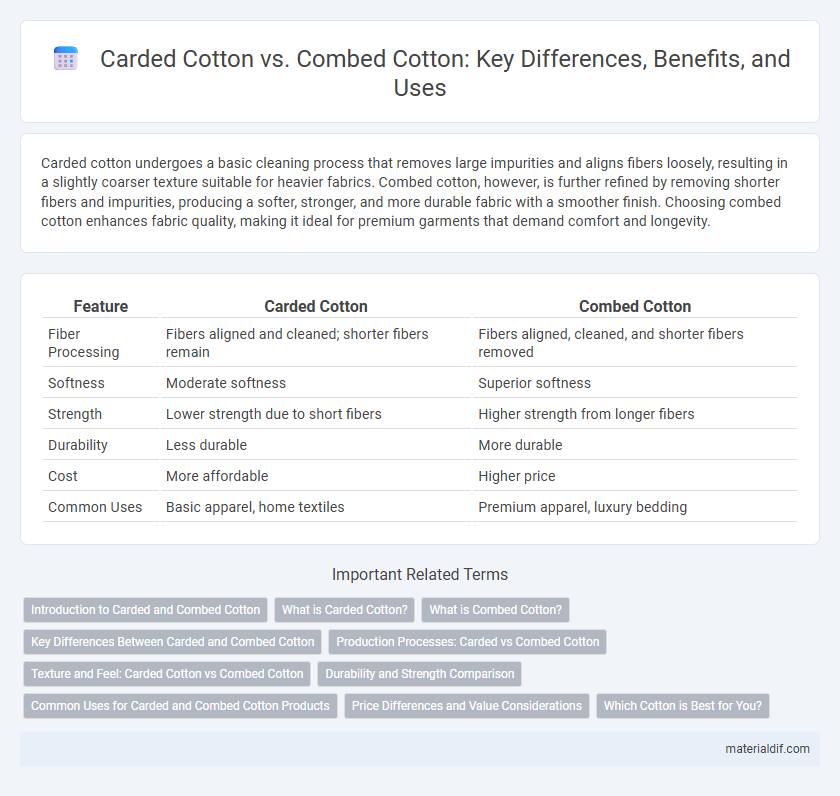Carded cotton undergoes a basic cleaning process that removes large impurities and aligns fibers loosely, resulting in a slightly coarser texture suitable for heavier fabrics. Combed cotton, however, is further refined by removing shorter fibers and impurities, producing a softer, stronger, and more durable fabric with a smoother finish. Choosing combed cotton enhances fabric quality, making it ideal for premium garments that demand comfort and longevity.
Table of Comparison
| Feature | Carded Cotton | Combed Cotton |
|---|---|---|
| Fiber Processing | Fibers aligned and cleaned; shorter fibers remain | Fibers aligned, cleaned, and shorter fibers removed |
| Softness | Moderate softness | Superior softness |
| Strength | Lower strength due to short fibers | Higher strength from longer fibers |
| Durability | Less durable | More durable |
| Cost | More affordable | Higher price |
| Common Uses | Basic apparel, home textiles | Premium apparel, luxury bedding |
Introduction to Carded and Combed Cotton
Carded cotton undergoes a process where raw cotton fibers are disentangled and cleaned using wire teeth, resulting in a coarser and less uniform fiber. Combed cotton is further refined by removing shorter fibers and impurities, producing a smoother, stronger, and finer material ideal for high-quality textiles. The distinction between carded and combed cotton impacts fabric softness, durability, and cost, with combed cotton generally preferred for premium garments.
What is Carded Cotton?
Carded cotton is a type of cotton fiber that undergoes a mechanical process called carding, which disentangles, cleans, and aligns the fibers to create a soft, fluffy texture ideal for spinning. This process removes most impurities but leaves some shorter fibers, resulting in a fabric with a coarser texture and increased durability compared to combed cotton. Carded cotton is commonly used in affordable textiles such as t-shirts, towels, and home furnishings due to its balanced cost and comfort.
What is Combed Cotton?
Combed cotton is a high-quality cotton fiber that undergoes an additional processing step to remove short fibers and impurities, resulting in a smoother and stronger yarn. This process enhances softness, durability, and fabric uniformity, making combed cotton ideal for premium clothing, bedding, and luxury textiles. Compared to carded cotton, combed cotton garments offer superior comfort, less pilling, and a finer texture.
Key Differences Between Carded and Combed Cotton
Carded cotton undergoes a mechanical process that removes large impurities while leaving shorter fibers intact, resulting in a coarser texture and lower quality. Combed cotton goes through an extra step where short fibers are removed, producing a smoother, stronger fabric with higher durability and softness. The key differences between carded and combed cotton lie in fiber length, purity, and fabric performance, with combed cotton preferred for premium textiles and carded cotton used in more affordable products.
Production Processes: Carded vs Combed Cotton
Carded cotton undergoes a process where raw fibers are disentangled, cleaned, and roughly aligned using wire brushes, resulting in a fiber mass with some impurities and shorter fibers retained. Combed cotton involves an additional step after carding where fine brushes remove shorter fibers and impurities, producing smoother, more uniform, and stronger fibers. The combing process enhances the softness and quality of the cotton, making combed cotton more suitable for higher-end textiles and garments.
Texture and Feel: Carded Cotton vs Combed Cotton
Carded cotton exhibits a coarser and more textured feel due to the presence of short fibers and impurities that remain after the carding process, resulting in a fabric with a slightly rough surface and less uniformity. Combed cotton undergoes an additional combing step that removes short fibers and aligns the longer fibers, producing a smoother, softer texture with enhanced strength and durability. The refined nature of combed cotton offers superior comfort and a luxurious feel, making it ideal for premium textiles and garments.
Durability and Strength Comparison
Carded cotton features fibers that are roughly aligned, resulting in a fabric with a slightly coarser texture and moderate strength, suitable for everyday use. Combed cotton undergoes an extra process to remove shorter fibers and impurities, producing a smoother, finer, and stronger fabric with enhanced durability. The removal of short fibers in combed cotton increases tensile strength and longevity, making it more resistant to wear and tear compared to carded cotton.
Common Uses for Carded and Combed Cotton Products
Carded cotton is commonly used in affordable textiles such as quilting, upholstery, and lightweight apparel due to its softer texture and cost-effectiveness. Combed cotton, prized for its superior smoothness and durability, is frequently found in premium products like high-end T-shirts, luxury bed linens, and fine underwear. Both types cater to different market needs, with carded cotton favored for bulkier, casual items and combed cotton ideal for garments requiring a finer, cleaner finish.
Price Differences and Value Considerations
Carded cotton typically costs less than combed cotton due to its simpler processing that retains more impurities, making it a budget-friendly option. Combed cotton undergoes an extra step that removes short fibers and impurities, resulting in a softer, stronger, and more durable fabric that justifies a higher price point. When choosing between carded and combed cotton, consumers weigh cost savings against improved fabric quality, comfort, and longevity offered by combed cotton.
Which Cotton is Best for You?
Carded cotton undergoes a basic cleaning process that removes larger impurities and aligns fibers loosely, resulting in a coarser, more textured fabric ideal for casual wear and affordability. Combed cotton is further refined by removing shorter fibers and impurities, producing smoother, stronger, and softer material suited for luxury clothing and sensitive skin. Choosing between carded and combed cotton depends on your preference for fabric softness, durability, and price sensitivity.
Carded Cotton vs Combed Cotton Infographic

 materialdif.com
materialdif.com